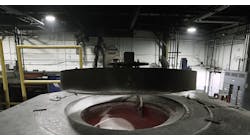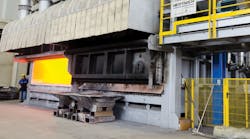Otto Fuchs KG is expanding its forged wheel-making operation at Meinerzagen, Germany, with plans to expand aluminum-melting capacity there. The forger and ring-roller is well-known for its automotive wheel products, and recently developed a new finishing operation near Meinerzhagen to combine wheel painting and surface treatment with logistics operations. “The constantly growing demands of our customers … with regard to production volume, variant diversity and surface design necessitated building a new surface and logistics center,“ Fuchs explained.
Fuchs produces customized aluminum and magnesium alloy automotive wheels for high-end vehicles, including Audi, BMW, Lamborghini, Mercedes, Porsche, and Rolls-Royce. The group forges 2.5 million wheels per year, as well as 41 million forged suspension parts, among other vehicle components.
Otto Fuchs also produces forgings, rings, and extrusions for aerospace markets; extrusions for construction projects; and forgings and extrusions for industrial engineering applications.
The upcoming expansion at Meinerzhagen will include a new shaft furnace for melting and two, tiltable holding and casting furnaces, to be supplied by Hertwich Engineering, an SMS group company.
The value of the contract was not reported.
A shaft furnace draws exhaust heat from the melting process to preheat scrap staged in a shaft, in advance of furnace charging. The Ecomelt-PS150 will be the fifth furnace of that design installed at Meinerzhagen, and will have a capacity of 7.7 metric tons per hour. Each of the two tilting furnaces will have a designed capacity of 20 metric tons.
The Ecomelt series is designed to gasify organic content mixed with the metallic scrap at approximately 400-500°C during the preheating stage. Otto Fuchs recycles return materials (e.g., ingot head and butt ends, burrs, and swarf) for quality and homogeneity, as well as process efficiency. Scrap is charged from the top into the vertical shaft and preheated by the off-gas to a maximum temperature of 500°C. Combustion gases are ducted from the main chamber to the melting chamber and the preheat shaft.
Once it descends to the bottom of the shaft, the preheated material is charged directly into the flowing melt bath, melting exclusively due to contact with liquid melt (submerged melting process.) An electromagnetic, liquid-metal pump ensures proper melt flow between the furnace chambers and the flooding of the shaft floor.
Ecomelt achieves nearly continuous heating, meaning that the charging and melting activities do not interrupt the operation of the main burner. Most of the melting energy is introduced to the melt in the main chamber in the form of radiant heat. Using a regenerator system ensures high combustion efficiency with low energy consumption (< 600 kWh/ton).
SMS noted that increasing demand for automotive aluminum products is raising the volume of scrap for recycling, citing a forecast for German scrap production volume to exceed 1.5 million metric tons in 2020.
The two single-chamber furnaces, which are part of this order as well, will be placed in the casthouse between the melting and casting units. Molten metal will be transferred from the Ecomelt melting furnace to one of these furnaces for possible re-alloying. Finally, the melt will be transferred via a casting launder to the casting machine, as needed. Both of these furnaces will be hydraulically tiltable — an arrangement that ensures a continuous casting operation and reduces downtime for alloy change.









